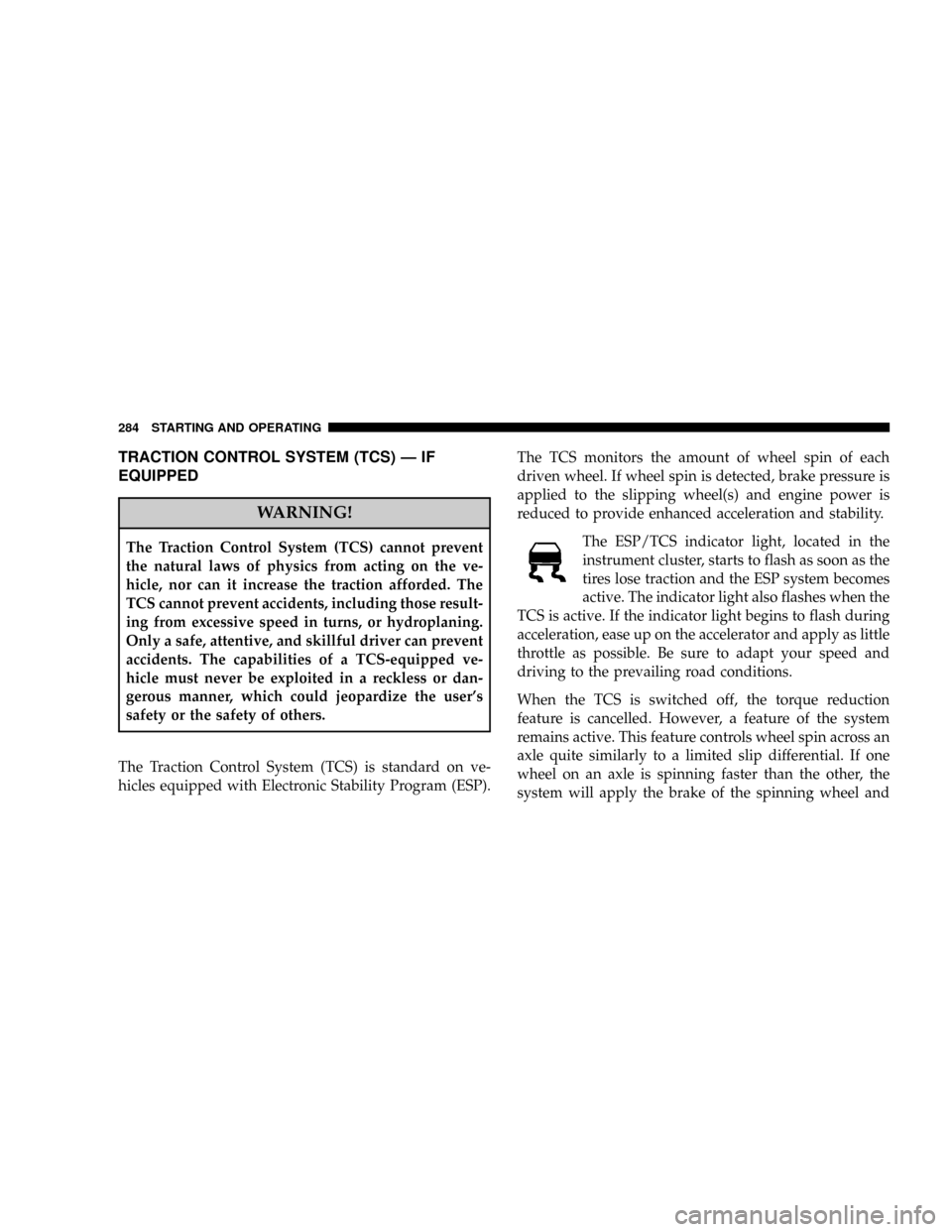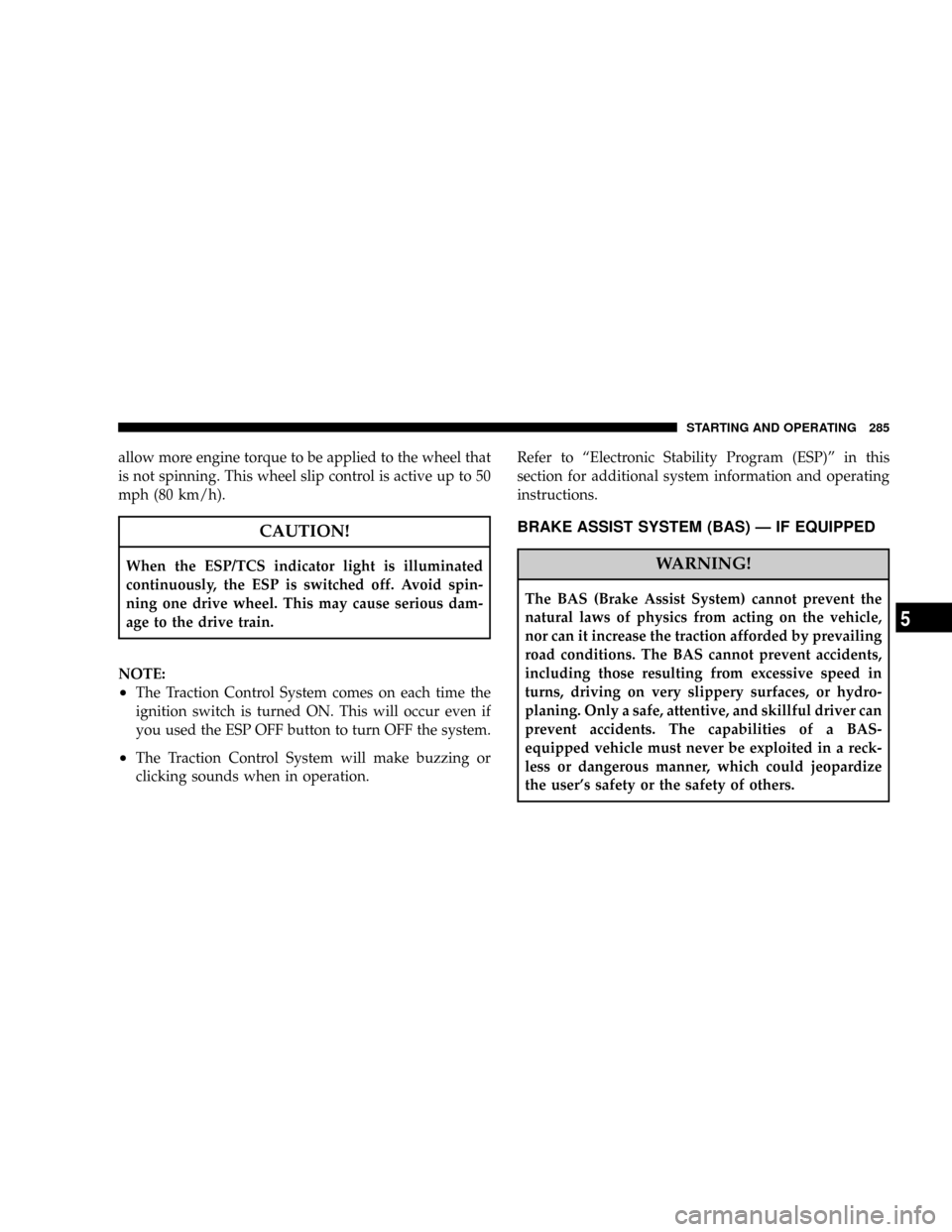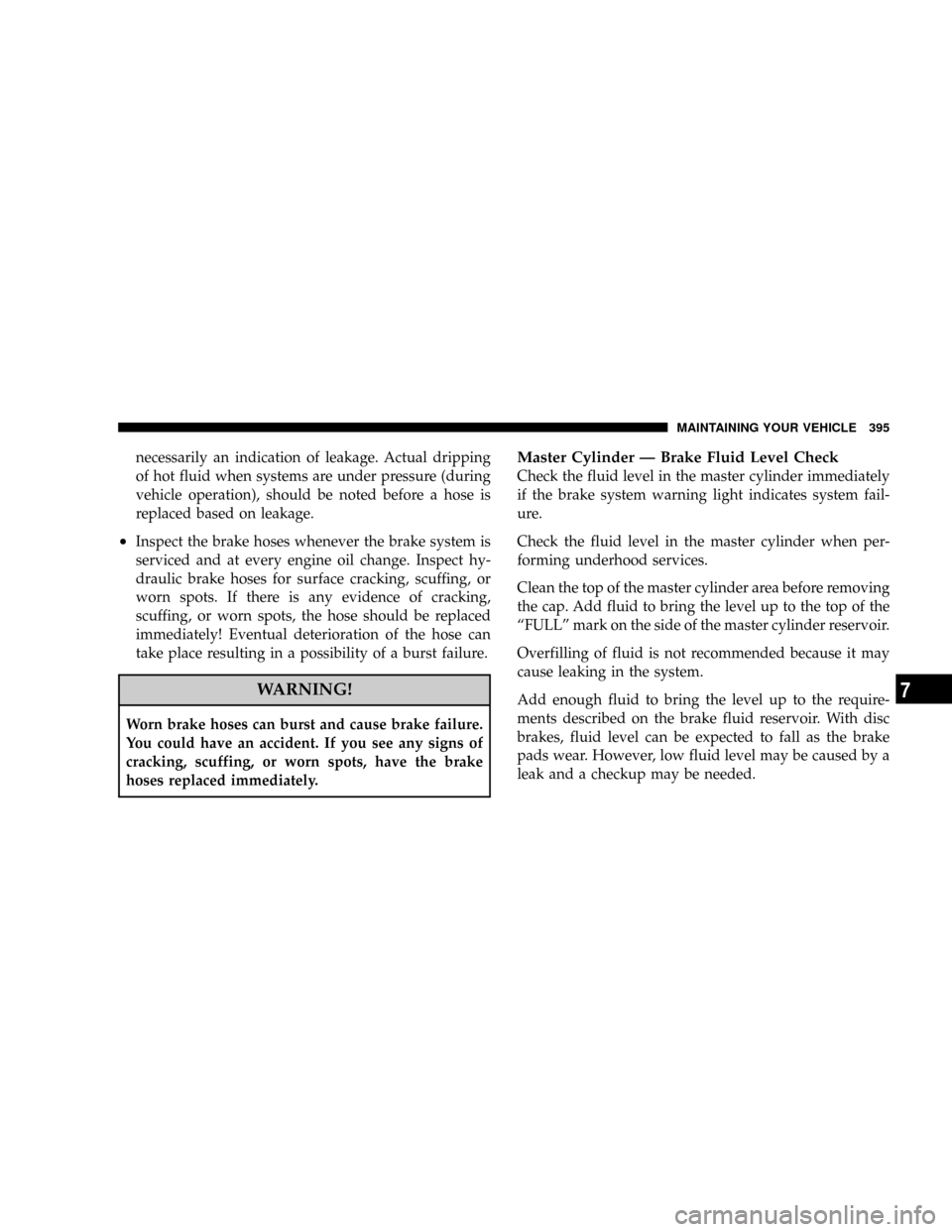Page 284 of 466

TRACTION CONTROL SYSTEM (TCS) Ð IF
EQUIPPED
WARNING!
The Traction Control System (TCS) cannot prevent
the natural laws of physics from acting on the ve-
hicle, nor can it increase the traction afforded. The
TCS cannot prevent accidents, including those result-
ing from excessive speed in turns, or hydroplaning.
Only a safe, attentive, and skillful driver can prevent
accidents. The capabilities of a TCS-equipped ve-
hicle must never be exploited in a reckless or dan-
gerous manner, which could jeopardize the user's
safety or the safety of others.
The Traction Control System (TCS) is standard on ve-
hicles equipped with Electronic Stability Program (ESP).The TCS monitors the amount of wheel spin of each
driven wheel. If wheel spin is detected, brake pressure is
applied to the slipping wheel(s) and engine power is
reduced to provide enhanced acceleration and stability.
The ESP/TCS indicator light, located in the
instrument cluster, starts to flash as soon as the
tires lose traction and the ESP system becomes
active. The indicator light also flashes when the
TCS is active. If the indicator light begins to flash during
acceleration, ease up on the accelerator and apply as little
throttle as possible. Be sure to adapt your speed and
driving to the prevailing road conditions.
When the TCS is switched off, the torque reduction
feature is cancelled. However, a feature of the system
remains active. This feature controls wheel spin across an
axle quite similarly to a limited slip differential. If one
wheel on an axle is spinning faster than the other, the
system will apply the brake of the spinning wheel and
284 STARTING AND OPERATING
Page 285 of 466

allow more engine torque to be applied to the wheel that
is not spinning. This wheel slip control is active up to 50
mph (80 km/h).
CAUTION!
When the ESP/TCS indicator light is illuminated
continuously, the ESP is switched off. Avoid spin-
ning one drive wheel. This may cause serious dam-
age to the drive train.
NOTE:
²The Traction Control System comes on each time the
ignition switch is turned ON. This will occur even if
you used the ESP OFF button to turn OFF the system.
²The Traction Control System will make buzzing or
clicking sounds when in operation.Refer to ªElectronic Stability Program (ESP)º in this
section for additional system information and operating
instructions.
BRAKE ASSIST SYSTEM (BAS) Ð IF EQUIPPED
WARNING!
The BAS (Brake Assist System) cannot prevent the
natural laws of physics from acting on the vehicle,
nor can it increase the traction afforded by prevailing
road conditions. The BAS cannot prevent accidents,
including those resulting from excessive speed in
turns, driving on very slippery surfaces, or hydro-
planing. Only a safe, attentive, and skillful driver can
prevent accidents. The capabilities of a BAS-
equipped vehicle must never be exploited in a reck-
less or dangerous manner, which could jeopardize
the user's safety or the safety of others.
STARTING AND OPERATING 285
5
Page 287 of 466

This system enhances directional control and stability of
the vehicle under various driving conditions. The ESP
corrects for oversteering and understeering the vehicle
by applying the brake of the appropriate wheel. Engine
power may also be reduced to assist in counteracting the
condition of oversteer or understeer and help the vehicle
maintain the desired path.
The ESP uses sensors in the vehicle to determine the path
that the driver intends to steer the vehicle and compares
it to the actual path of the vehicle. When the actual path
does not match the intended path, the ESP applies the
brake of the appropriate wheel to assist in counteracting
the condition of oversteer or understeer.²Oversteer - when the vehicle is turning more than
appropriate for the steering wheel position.
²Understeer - when the vehicle is turning less than
appropriate for the steering wheel position.
The ESP/TCS Indicator Light, located in the
instrument cluster, starts to flash as soon as the
tires lose traction and the ESP system becomes
active. The indicator light also flashes when the
TCS is active. If the indicator light begins to flash during
acceleration, ease up on the accelerator and apply as little
throttle as possible. Be sure to adapt your speed and
driving to the prevailing road conditions.
STARTING AND OPERATING 287
5
Page 288 of 466
The ESP OFF button is located in the center of the
instrument panel. To turn OFF the ESP, momentarily
press the ESP OFF button and the ESP/TCS Indicator
Light will illuminate. To turn the system ON again,
momentarily press the ESP OFF button and the indicator
light will turn OFF.NOTE:To improve the vehicle's traction when driving
with snow chains, or starting off in deep snow, sand, or
gravel, switch off the ESP by pressing the ESP OFF button.
CAUTION!
When the ESP/TCS Indicator Light is illuminated
continuously, the ESP is switched off. Avoid spin-
ning one drive wheel. This may cause serious dam-
age to the drive train.
CAUTION!
If the vehicle is towed with the front axle raised, the
engine must be shut off (key in the ignition switch to
the OFF/LOCK or ACC position). Otherwise, the ESP
will immediately be engaged and it will apply the
rear wheel brakes.
288 STARTING AND OPERATING
Page 339 of 466
WARNING!
Do not connect trailer brakes to your vehicle's hy-
draulic brake lines. It can overload your brake sys-
tem and cause it to fail. You might not have brakes
when you need them and could have an accident.
Towing any trailer will increase your stopping dis-
tance. When towing, you should allow for additional
space between your vehicle and the vehicle in front
of you. Failure to do so could result in an accident.
Towing Requirements Ð Trailer Lights & Wiring
Whenever you pull a trailer, regardless of the trailer size,
stoplights and turn signals on the trailer are required for
motoring safety.
The Trailer Tow Package may includea4and7pin
wiring harness. Use a factory approved trailer harness
and connector.
NOTE:Do not cut or splice wiring into the vehicles
wiring harness.
STARTING AND OPERATING 339
5
Page 364 of 466

NMaintenance-Free Battery................381
NAir Conditioner Maintenance.............383
NA/C Air Filter Ð If Equipped............384
NPower Steering Ð Fluid Check............384
NFront & Rear Suspension Ball Joints........385
NSteering Linkage......................385
NBody Lubrication.....................385
NWindshield Wiper Blades................386
NWindshield Washers...................386
NExhaust System......................387
NCooling System.......................388
NHoses And Vacuum/Vapor Harnesses.......393
NFuel System.........................393NBrake System........................394
NAutomatic Transmission................396
NAll Wheel Drive (AWD) Ð If Equipped.....398
NFront And Rear Wheel Bearings...........398
NAppearance Care And Protection From
Corrosion...........................398
NCleaning The Center Console Cup Holders . . . 403
mFuses (Power Distribution Centers)..........404
NFuses (Front Power Distribution Center).....404
NFuses (Rear Power Distribution Center)......406
mVehicle Storage........................411
mReplacement Light Bulbs.................412
mBulb Replacement......................413
364 MAINTAINING YOUR VEHICLE
Page 395 of 466

necessarily an indication of leakage. Actual dripping
of hot fluid when systems are under pressure (during
vehicle operation), should be noted before a hose is
replaced based on leakage.
²Inspect the brake hoses whenever the brake system is
serviced and at every engine oil change. Inspect hy-
draulic brake hoses for surface cracking, scuffing, or
worn spots. If there is any evidence of cracking,
scuffing, or worn spots, the hose should be replaced
immediately! Eventual deterioration of the hose can
take place resulting in a possibility of a burst failure.
WARNING!
Worn brake hoses can burst and cause brake failure.
You could have an accident. If you see any signs of
cracking, scuffing, or worn spots, have the brake
hoses replaced immediately.
Master Cylinder Ð Brake Fluid Level Check
Check the fluid level in the master cylinder immediately
if the brake system warning light indicates system fail-
ure.
Check the fluid level in the master cylinder when per-
forming underhood services.
Clean the top of the master cylinder area before removing
the cap. Add fluid to bring the level up to the top of the
ªFULLº mark on the side of the master cylinder reservoir.
Overfilling of fluid is not recommended because it may
cause leaking in the system.
Add enough fluid to bring the level up to the require-
ments described on the brake fluid reservoir. With disc
brakes, fluid level can be expected to fall as the brake
pads wear. However, low fluid level may be caused by a
leak and a checkup may be needed.
MAINTAINING YOUR VEHICLE 395
7
Page 408 of 466
Cavity Car-
tridge
FuseMini
FuseDescription
8 Ð 15 Amp
BlueDiagnostic Link Connec-
tor (DLC)/Wireless Con-
trol Module (WCM)/
Wireless Ignition Node
(WIN)
9 Ð 20 Amp
YellowPower Outlet
10ÐÐÐ
11*ÐÐÐ
12*ÐÐÐ
13*ÐÐÐ
14 Ð 10 Amp
RedAC Heater Control/
Cluster/Security Mod-
ule - if equipped
15 Ð 20 Amp
YellowTrailer Tow Brake Mod-
ule - if equippedCavity Car-
tridge
FuseMini
FuseDescription
16ÐÐÐ
17 Ð 20 Amp
YellowCluster
18 Ð 20 Amp
YellowSelectable Power Outlet
19 Ð 10 Amp
RedStop Lights
20ÐÐÐ
21ÐÐÐ
22ÐÐÐ
23ÐÐÐ
24ÐÐÐ
25ÐÐÐ
26ÐÐÐ
408 MAINTAINING YOUR VEHICLE